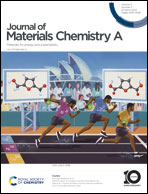Gravity-induced single-layer gradient structure of Ni@Ti3C2Tx/PVA for enhanced microwave absorption†
Abstract
Gradient structure design to improve impedance matching is one of the key methods to realize strong and broadband microwave absorption. However, almost all the reported gradient structures are multilayered and fabricated via a layer-by-layer process which is not applicable for mass production. Moreover, the bonding force between layers and bonding durability are usually weak, leading to potential material disassembly. Herein, a novel single-layer gradient structure (SLGS) is developed for the first time and successfully constructed via one-step gravity-induced sedimentation of Ni@Ti3C2Tx in a polyvinyl alcohol (PVA) matrix. Notably, the gradient can be easily tuned through changing the viscosity of the PVA solution. With an optimized gradient, the minimum reflection loss of Ni@Ti3C2Tx/PVA SLGS reaches −57.7 dB with an effective absorbing bandwidth of 3.2 GHz in the X band at a thickness of 2.22 mm. The impressive absorbing performance is ascribed to remarkable impedance matching which is demonstrated to be more crucial than attenuation ability. This work opens the mind to build an SLGS instead of a traditional multilayer gradient structure and offers a new idea to tune microwave absorbing performance through tuning filler distribution in the matrix.



 Please wait while we load your content...
Please wait while we load your content...